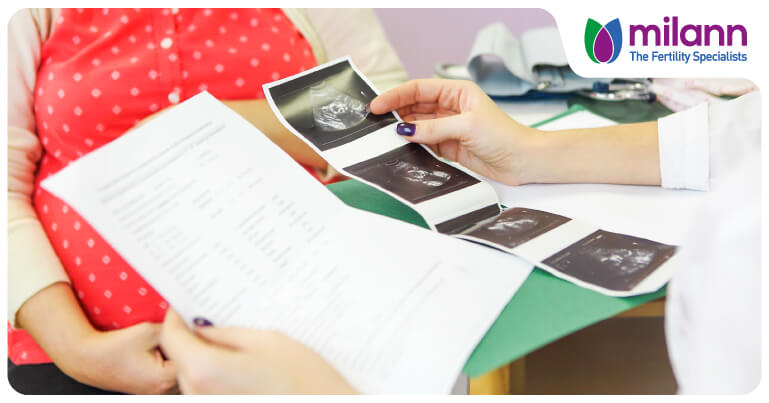You’ve just had a growth scan, and now you’re holding a report filled with medical terms like "BPD," "FL," and "EFW." It can feel overwhelming, especially if you’re navigating your first pregnancy or going through it after IVF. But understanding your growth scan report doesn’t have to be intimidating. It’s one of the most empowering things you can do for your mental well-being.
A growth scan, usually performed between 28 and 36 weeks of pregnancy, helps your doctor assess how well your baby is growing inside the womb. It tracks key fetal growth scan parameters, measures vital organs and limbs, and flags any potential concerns well before your due date.
Let’s break down the essentials of your growth scan report so you know what’s normal, what’s not, and when to seek a second opinion.
What Is Measured In A Growth Scan?
During a fetal growth scan, your doctor uses ultrasound technology to assess key measurements that provide insight into your baby’s development and estimated weight. One of the primary metrics is the Biparietal Diameter (BPD), which measures the width of your baby’s head from one side to the other and helps evaluate brain growth and head size. The Femur Length (FL), the length of the thigh bone, is another important marker used to assess skeletal development and overall fetal growth. Head Circumference (HC) provides additional insight into cranial growth patterns. At the same time, Abdominal Circumference (AC) is a crucial indicator of fetal nutrition and liver size, often used to detect potential growth restrictions. These measurements are combined to calculate the Estimated Fetal Weight (EFW), giving your doctor an approximation of your baby’s current size. Another key parameter is the Amniotic Fluid Index (AFI), which assesses the amount of amniotic fluid surrounding your baby; abnormal levels may indicate issues with the placenta or fetal kidneys. Together, these metrics help ensure that your baby is growing well and developing as expected.
What’s Considered Normal in a Growth Scan Report?
Most growth scan parameters are interpreted using standard ranges based on gestational age, and your doctor will often plot these measurements on a percentile growth chart to assess your baby’s development. An Estimated Fetal Weight (EFW) between the 10th and 90th percentile is generally considered within the normal range. If your baby’s weight falls below the 10th percentile, they may be classified as Small for Gestational Age (SGA), which could require closer monitoring for signs of restricted growth. When measurements like Abdominal Circumference (AC) or Femur Length (FL) are significantly smaller than the Biparietal Diameter (BPD), it may indicate asymmetrical growth, often associated with placental insufficiency. The Amniotic Fluid Index (AFI) is another important marker, with a normal range typically between 8 and 18 cm. Values below 5 cm (oligohydramnios) or above 24 cm (polyhydramnios) may signal concerns requiring further evaluation. It’s important to remember that these values are not absolute; a baby on the smaller side can still be perfectly healthy if growth is steady, and a larger baby isn’t automatically a sign of gestational diabetes. Context and consistency matter more than a single number.
What A Growth Scan Report Does Not Tell You
While a growth scan report is an invaluable tool for tracking your baby’s development, it does have its limitations. The Estimated Fetal Weight (EFW) is just that, an estimate, and can vary by ±10–15%, meaning it may not precisely predict your baby’s birth weight. Growth scans also cannot reliably detect chromosomal abnormalities; such conditions typically require genetic screening or a detailed anomaly scan earlier in pregnancy. Most importantly, a scan should never override your maternal instincts. If you notice reduced movement, unusual pain, or any sudden changes, always trust your body and consult your doctor, because no report can replace your inner sense that something may not be right.
When Should You Seek A Second Opinion
If your growth scan report shows unusual measurements or mentions terms like IUGR (Intrauterine Growth Restriction), it’s completely natural to feel concerned, but what matters most is taking timely action. Early detection allows for close monitoring and interventions that can significantly improve outcomes.
For instance, if your baby’s Estimated Fetal Weight (EFW) is dropping across percentile lines, if amniotic fluid levels are lower than normal, or if Doppler studies show reduced blood flow to the placenta, your doctor may recommend more frequent scans, nutritional support, or in some cases, even early delivery to ensure your baby’s safety. While these findings can be stressful, they also offer a valuable opportunity to step in early and optimize care for both you and your baby.
Book A Consultation At Milann
At Milann, we know how much every number in that report matters, especially for IVF pregnancies or high-risk moms. Our fetal medicine team is trained to read beyond the numbers and offer you clarity, not confusion.
Upload your report today for a second opinion or schedule a consultation. Your baby’s growth deserves expert attention.
Reviewed by
Dr. Rubeena Zainab Consultant - Reproductive Medicine, Indiranagar.
